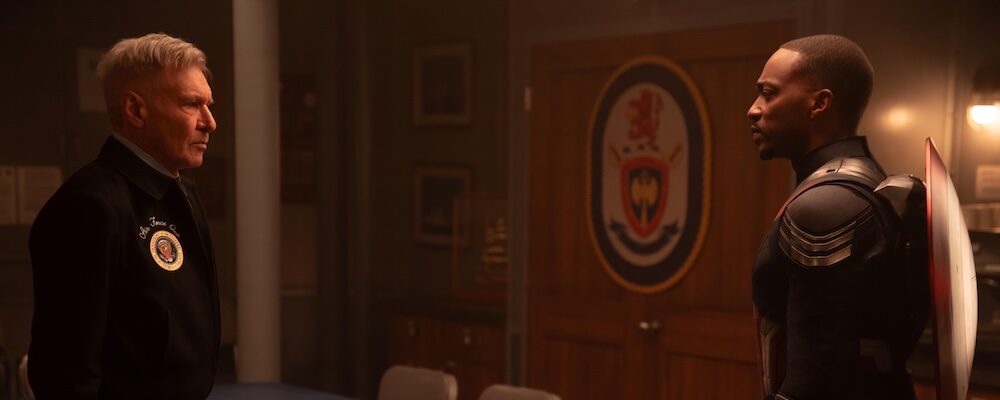‘Captain America: Brave New World’: Another Marvel Throwaway Struggles To Find New Formulas
Alci Rengifo
On a purely surface level of pop art history, there is value to what “Captain America: Brave New World” initiates with its famous, patriotic namesake. Anthony Mackie taking on the mantle of Captain America continues to settle the debate of how superheroes can easily evolve for strong representation. A Black actor playing Captain America is another one of those welcome steps the MCU tends to take within the world of popcorn blockbusters. However, this fun shift in pop iconography is taking place as Marvel is still struggling to adjust its behemoth franchise into something that can still generate excitement and not overkill. “Brave New World” feels like another throwaway project made to remind us the studio is still around.
You may remember from the Disney+ series “The Falcon and the Winter Soldier” that Sam Wilson (Mackie) aka Falcon had been hesitant about taking over the Captain America job from Steve Rogers. Now he’s fully in the role, fighting bad guys with sidekick Joaquin Torres (Danny Ramirez), who is being trained to be the new Falcon. Over in Washington, D.C., Thaddeus “Thunderbolt” Ross (Harrison Ford taking over from the late William Hurt), has now been elected president. The world is nervous since Ross is famous for being the hot-tempered general obsessed with hunting down the Hulk. His first order of business is to settle multinational treaties around Celestial Island, the frozen god mass you may recall from “Eternals,” where adamantium has been discovered (if you don’t know what that is, you never watched “X-Men”). A shocking assassination attempt ignites a major crisis that could eventually lead to a showdown with Japan over the newly-discovered metal alloy.
“Captain America: Brave New World” appears to be fashioned as a sort of political thriller. The poster references paranoid classics and even a famous shot from Andrzej Wajda’s “Ashes and Diamonds.” Harrison Ford makes perfect sense for casting, since he played Jack Ryan in two Tom Clancy adaptations in the 1990s. Yet, director Julius Onah and the four other writers attached don’t push the plot any further than a standard, by-the-numbers mini adventure to keep the franchise running. For longtime fans this is another title that connects to a movie from eons ago, 2008’s “The Incredible Hulk.” Quickly enough the villain is revealed to be Samuel Sterns (Tim Blake Nelson), the researcher who tried to cure the Hulk and ended up with some Hulk-infected plasma dropping on his head. Now he’s a green, altered mad scientist eager to destroy Ross’ legacy.
Like most of the other characters, Sterns isn’t given much to do aside from stand around making ominous phone calls and cackle beneath bulbous makeup that seems borrowed from an alien race from “Star Trek” or “Galaxy Quest.” He’s a villain that could be replaced by anyone to serve the same purpose. The same goes for side characters one suspects are merely introductions for upcoming plotlines in future films, like Sidewinder (an always eloquently menacing Giancarlo Esposito), leader of the Serpent Society or Ross’ security adviser, Ruth Bat-Seraph (Shira Haas), an Israeli who was once trained as a Black Widow. This character comes with some baggage since she was originally meant to be Mossad agent and Israeli superhero Sabra. Once the war in Gaza erupted, Disney figured it was best to change the character’s background. Either way, she’s also more of a side prop.
Some of the story’s more promising angles emerge here and there before getting swallowed by the MCU motions. Mackie’s Captain America was written intelligently in “Falcon and the Winter Soldier” as a Black American dealing with representing a patriotic idea of a nation that has been a source of oppression. In the show we met Isaiah Bradley (Carl Lumbly), who during the Korean War had been part of the same super soldier program that produced the original Captain. His storyline was a potent indictment of American racism, since a Black Captain America in the ‘50s was less than popular and he soon found himself in prison being used for experiments. “Brave New World” briefly touches on the subject before turning him into a mere plot device for Sterns’ scheme. The movie’s more striking, probably unintentionally satirical imagery comes when Ross transforms into the Red Hulk and smashes the White House and other corners of the nation’s seat of power. Considering we do have a stomping anger machine currently occupying the Oval Office, these sequences should become instant fodder for political meme makers.
“Brave New World” has the overall feel of the quick-consumption comic book movies that were made in the ‘80s and ‘90s before Marvel inaugurated the genre’s era of cultural dominance. There’s a lot of corny writing about duty along with your basic action scenes, here done with little real energy except for a few impressive moments where Captain and Falcon crisscross the skies, confronting Japanese fighter jets. Too much of feels like an extended episode of the MCU shows that have contributed to the studio’s oversaturation, with even the end credits bonus scene offering little that’s fun or funny (in fact, a lot of the movie lacks genuine humor). Liv Tyler also drops in as a missed opportunity, reprising her role from “The Incredible Hulk” for the briefest cameo ever in the MCU. The rest is merely more set up for the next round of movies we’re expected to consume. Just because it’s meant to be popcorn fun does not mean it should lack at the very least some heart and more cheerful creativity.
“Captain America: Brave New World” releases Feb. 14 in theaters nationwide.

